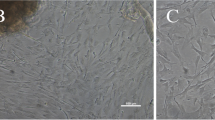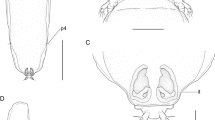Abstract
The Puntius denisonii colloquially and more popularly referred to as Miss Kerala is a subtropical fish belonging to the genus Puntius (Barb) and family Cyprinidae. Two cell lines PDF and PDH were developed from the caudal fin and heart of P. denisonii, respectively. The cell lines were optimally maintained at 26°C in Leibovitz-15 medium supplemented with 10% fetal bovine serum. A diploid count of 50 chromosomes at passage 50 was observed in both the cell lines. The high growth potential of the cell lines was reflected from the cell doubling time of 28 and 30 h of PDF and PDH cell lines, respectively. The viability of the PDF and PDH cell lines was 70% and 76%, respectively, after 4 mo of storage in liquid nitrogen (−196°C). The origin of the cell lines was confirmed by the amplification of 653 bp fragments of cytochrome oxidase subunit I of mitochondrial DNA genes.



Similar content being viewed by others
References
Bejar J.; Borrego J. J.; Alvarez M. C. A continuous cell line from the cultured marine fish gilt-head seabream (Sparus aurata L.). Aquaculture 150: 143–153; 1997.
Chang S. F.; Ngoh G. H.; Kueh L. F. S.; Qin Q. W.; Chen C. L.; Lam T. J.; Sin Y. M. Development of a tropical marine fish cell line from Asian seabass (Lates calcarifer) for virus isolation. Aquaculture 192: 133–145; 2001.
Chi S. C.; Hu W. W.; Lo B. J. Establishment and characterization of a continuous cell line (GF-1) derived from grouper, Epinephelus coioides (Hamilton): a cell line susceptible to grouper nervous necrosis virus (GNNV). J Fish Dis 22: 173–182; 1999.
Cooper J. K.; Sykes G.; King S. Species identification in cell culture: a two-pronged molecular approach. In vitro Cell Dev Biol 43: 344–351; 2007.
Freshney R. I. Culture of animal cells: a manual of basic technique. Wiley-Liss, New York; 1994.
Fryer J. L.; Lannon C. N. Three decades of fish cell culture: a current listing of cell lines derived from fish. J Tissue Cult Methods 16: 87–94; 1994.
Hameed A. S. H.; Parameswaran V.; Shukla R.; Singh I. S. B.; Thirunavukkarasu; Bhonde R. R. Establishment and characterization of India’s first marine fish cell line (SISK) from the kidney of sea bass (Lates calcarifer). Aquaculture 257: 92–103; 2006.
Hansen M. B.; Nielsen S. E.; Berg K. Re-examination and further development of a precise and rapid dye method for measuring cell growth/cell kill. J Immunol Methods 119: 203–210; 1989.
Hebert P. D. N.; Cywinska A.; Ball S. L.; Waard J. R. D. Biological identifications through DNA barcodes. Proceedings of Royal Society of London. B 270: 313–321; 2003.
Lai Y. S.; John J. A. C.; Lin C. H.; Guo I. C.; Chen S. C.; Fang K.; Lin C. H.; Chang C. Y. Establishment of cell lines from a tropical grouper, Epinephelus awora (temminck & schelegel), and their susceptibility to grouper irido- and nodaviruses. J Fish Dis 26: 31–42; 2003.
Lakra W. S.; Bhonde R. R.; Sivakumar N.; Ayyappan S. A new fibroblast like cell line from the fry of golden masher Tor putitora (Ham). Aquaculture 253: 238–243; 2006a.
Lakra W. S.; Sivakumar N.; Goswami M.; Bhonde R. R. Development of two cell culture systems from Asian seabass Lates calcarifer (Bloch). Aquaculture Res 37: 18–24; 2006b.
Lakra W. S.; Swaminathan T. R.; Rathore G.; Goswami M.; Yadav K.; Kapoor S. Development of three new diploid cell lines from Labeo rohita. Biotechnol Prog 26(4): 1008–1013; 2010.
Mathew D. M. ‘Miss Kerala’ finds spot on IUCN Red List. The Hindu, 31 January 2010; 2010.
Mercy T. V. A.; Goapalakrishnan A.; Kapoor D.; Lakra W. S. Ornamental fishes of the Western Ghats of India. NBFGR, Lucknow, p 70; 2007.
Mohan C. V.; Shankar K. M. Role of fungus in epizootic ulcerative syndrome of fresh and brackishwater fishes of Karnataka, India. Current Science 66: 656–658; 1994.
NBFGR, Fish chromosome atlas. National Bureau of Fish Genetic Resources Special Publication, No. 1. Lucknow, India, pp 332; 1998.
Nicholson B. L.; Danner D. J.; Wu J. L. Three new continuous cell lines from marine fishes of Asia. In vitro Cell Dev Biol 23: 199–204; 1987.
Parameswaran V.; Ahmed V. P. I.; Shukla R.; Bhonde R. R.; Hameed A. S. S. Development and characterization of two new cell lines from milkfish (Chanos chanos) and grouper (Epinephelus coioides) for virus isolation. Mar Biotech 9: 281291; 2007.
Parameswaran V.; Shukla R.; Bhonde R. R.; Hameed A. S. S. Splenic cell line from sea bass, Lates calcerifer: establishment and characterization. Aquaculture 261: 43–53; 2006.
Plumb J. A.; Wolf K. Fish cell growth rates: quantitative comparison of RTG-2 cell growth at 5–25°C. In Vitro Cell Dev Biol Plant 7(1): 1054–5476; 1971.
Roberts R. J.; Willoughby L. G.; Chinabut S. Mycotic aspect of epizootic ulcerative syndrome (EUS) of Asian fishes. J Fish Dis 16: 169–183; 1993.
Ruzzante D. E.; Taggart C. T.; Cook C.; Goddard S. Genetic differentiation between inshore and offshore Atlantic cod (Gadus morhua) off Newfoundland: microsatellite DNA variation and antifreeze level. Can J Fish Aquat Sci 53: 634–645; 1996.
Tong S. L.; Lee H.; Miao H. Z. The establishment and partial characterization of a continuous fish cell line FG- 9307 from the gill of flounder. Paralichthys olivaceus. Aquaculture 156: 327–333; 1997.
Tong S. L.; Miao H. Z.; Li H. Three new continous fish cell lines of SPH, SPS, and RSBF derived from sea perch (Lateolabrax japonicus) and red sea bream (Pagrosomus major). Aquaculture 169: 143–151; 1998.
Wakamatsu Y. Establishment of a melanoma cell line from the platyfish–swordtail hybrid. Cancer Res 41: 679–680; 1981.
Ward R. D.; Zemlak T. S.; Innes B. H.; Last P. R.; Hebert P. D. N. DNA barcoding Australia’s fish species. Philos Trans R Soc Lond, Ser B 360: 1847–1857; 2005.
Ye H. Q.; Chen S. L.; Sha Z. X.; Xu M. Y. Development and characterization of cell lines from heart, liver, spleen and head kidney of sea perch Lateolabrax japonicus. J Fish Biol 69: 115–126; 2006.
Acknowledgments
The authors thank Dr. S. Ayyappan, Director General, Indian Council of Agricultural Research, for his support and encouragement for the research program. The authors also thank Dr. V. S. Basheer of NBFGR, Kochi Unit, for his help in collecting the fish samples.
Author information
Authors and Affiliations
Corresponding author
Additional information
Editor: J. Denry Sato
Rights and permissions
About this article
Cite this article
Lakra, W.S., Goswami, M., Yadav, K. et al. Development and characterization of two cell lines PDF and PDH from Puntius denisonii (Day 1865). In Vitro Cell.Dev.Biol.-Animal 47, 89–94 (2011). https://doi.org/10.1007/s11626-010-9374-3
Received:
Accepted:
Published:
Issue Date:
DOI: https://doi.org/10.1007/s11626-010-9374-3




